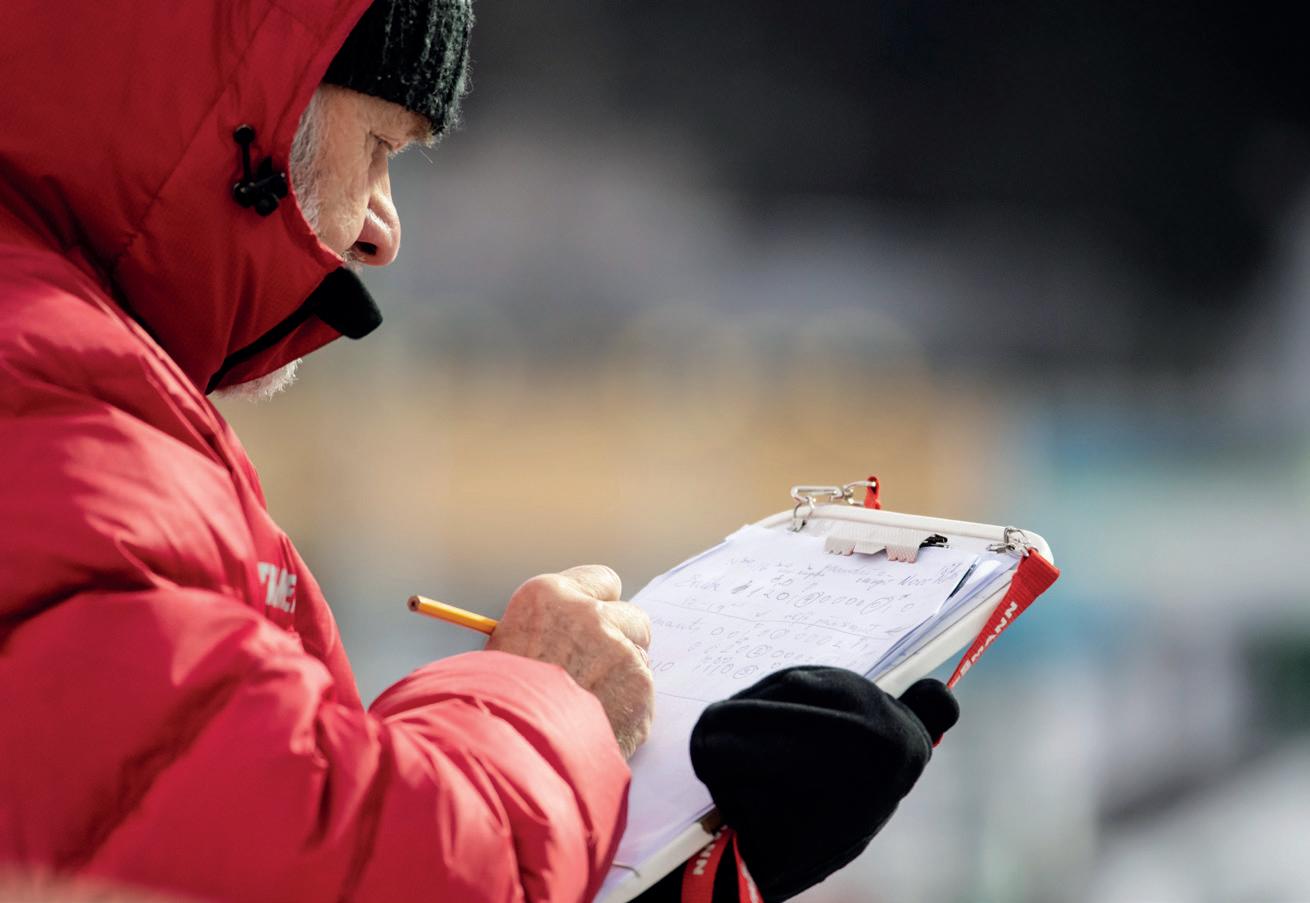Athlete monitoring - the foundation for informed decision-making
ØYVIND KARLSSON
Swedish Winter SportsResearch Centre, Department of Health Sciences, Mid SwedenUniversity, Östersund, Sweden
https://doi.org/10.71006/VRPV5594
Athlete monitoring is considered essential for optimizing training and protecting the health of athletes. It involves the collection of a wide range of variables related to both training and competition, as well as non-training-related variables such as recovery, health, travel, and general well-being. The overarching goal of athlete monitoring is to facilitate informed decisions that can improve the training process and ultimately enhance performance. While a plethora of methods are available, choosing the ones appropriate for your specific context is key to succeeding with athlete monitoring over time.
INTRODUCTION
Careful organization and management of an athlete‘s training and recovery processes are essential to facilitate positive adaptations that improve performance. Excessive training loads or insufficient recovery, or a combination of both, may hinder the positive adaptations to training, potentially compromising athletic performance and health through injuries and illness or conditions such as non-functional overreaching or the overtraining syndrome. Athlete monitoring can be a valuable tool to ensure that the prescribed training induces the desired effects on performance and health outcomes. In this text, I will cover the basics of athlete monitoring and key factors for successfully implementing and maintaining an athlete monitoring program.

WHAT IS ATHLETE MONITORING?
Athlete monitoring can be defined as the ongoing, systematic collection and analysis of information about an athlete and their training process (Timmerman et al., 2024). A successful athlete monitoring program can help us maximize the positive effects of training, such as improved fitness and increased readiness while at the same time minimizing the negative effects such as excessive fatigue, injury and illness by facilitating informed decisions about the training process. While there is agreement that athlete monitoring is essential to optimize the training and protect the health of athletes there is currently no agreement on the most suitable approach. Due to the diverse range of settings in which athlete monitoring is carried out, it is important to consider the specific context and tailor the choice of methods accordingly. Factors such as level of performance, availability of resources and team culture should be considered when selecting tools, as well as the specific objectives of the monitoring. Box 1 summarizes some key questions to ask yourself before implementing an athlete monitoring program.

Key questions
• Why do I want to monitor my athletes (e.g., performance optimization, injury and/or illness prevention)?
• Which measures should be used (e.g., heart rate, lactate, questionnaires, medical notes)?
• Who should record the data (e.g., the athlete, coach, medical team)?
• How often should athlete monitoring data be collected (e.g., every session, daily, weekly, monthly)?
• For how long should the monitoring continue (e.g., training camp, training phase, season, career)?
• When and how should feedback be provided (e.g., daily, weekly, face-to-face, app)?
• Do I have the necessary resources to implement an athlete monitoring program (e.g., time, personnel, finances, knowledge)?
CORE COMPONENTS OF AN ATHLETE MONITORING PROGRAM
At the core of every athlete monitoring program is quantifying the training load – after all, training is our main instrument to improve performance. Typically, training load is divided into external and internal load measures. External load measures quantify what the athlete has done, independent of the athlete’s internal responses. Measures of external load include training or competition time, type of training or competition activity, power output, speed, and distance. Internal load measures quantify the athlete’s physiological and psychological response to the external load. Typically, internal load measures are divided into objective (e.g., heart rate and lactate) and subjective measures (e.g., rating of perceived exertion, perceived stress, and perceived recovery). Using a combination of external and internal measures, and internal subjective load measures in addition to measures of athlete well-being and readiness, provides a solid foundation for understanding how the athlete is coping with the current training and informs day-to-day decisions about adjustments to the training program. However, it is also important to recognize that training load is not an isolated variable; other intrinsic and extrinsic factors, such as age, sex, family situation, travels, and environmental factors, can affect how the athlete responds to the training program.
THE ATHLETE MONITORING CYCLE
The athlete monitoring cycle, proposed by Gabbett and colleagues (2017), is a step-by-step approach for interpreting athlete monitoring data from multiple sources to inform the ongoing training process, from one training session or competition to the next. By assessing measures of external load, internal load, perceptual well-being, and the athlete’s readiness to train or compete in combination, informed decisions about training adjustments can be made.
The first step in the athlete monitoring cycle is to evaluate the relationship between external load (i.e., the activities performed by the athlete) and internal load (i.e., the athlete‘s physiological response to these activities). If an athlete exhibits a higher-thanusual internal load in response to a specific external load – such as an elevated heart rate at a given power output – adjustments to the external load in future training sessions may be necessary.
The second step involves evaluating load measures alongside an assessment of the athlete‘s perceptual well-being. This provides additional insight into how the athlete is coping with their current training regimen. High training loads are not the only factors that can impact an athlete’s well-being. Other sources of stress, such as family situations, work, school, or studies, may also influence how they respond to training.
Finally, the third step involves evaluating the athlete’s perceptual well-being alongside a subjective or objective assessment of their readiness to train or compete. Based on this evaluation, the athlete may be deemed ready for another training session or competition, the next session might need adjustments, or they may require additional recovery or further mental and/or physical preparation before the next session or event. For further details about the athlete monitoring cycle, see Gabbett et al. (2017).
MONITORING
INJURY AND ILLNESS MONITORING
Injury and illness monitoring is a crucial component of an athlete monitoring program, and fundamental for protecting athlete health and optimizing performance (Bahr et al. 2020). Generally, when recording injuries or illnesses, the event should be documented in as much detail as possible, given the information available and the expertise of the individual reporting. Ideally, this task should be performed by a medical professional. However, this is not always feasible. When injury data is reported by athletes or non-medical staff, it is recommended to limit the reporting to the body area, as their descriptions of tissue type and pathology are often unreliable. Similarly, when athletes or non-clinical recorders, such as coaching staff, are asked to record illness data, they should focus on documenting symptoms rather than attempting to provide a specific diagnosis.
Recommendations for Coaches
If you don’t have access to a medical team or doctor, a suitable approach might be: to get the athlete to record:
• The day of the injury or the day of the first symptoms of an illness.
• Body area/location in case of an injury or basic symptoms of an illness.
• Some measure of severity, for example, full participation, modified training, or unavailable for training and competition.
• Day of full return to training and competition.
For further guidelines on implementing and carrying out injury and illness monitoring, please refer to the International Olympic Committee‘s consensus statement: methods for recording and reporting of epidemiological data on injury and illness in sport (Bahr et al., 2020).
Taken together, a well-executed athlete monitoring program can be instrumental in optimizing training outcomes and safeguarding athlete health. By systematically integrating data from multiple sources, athlete monitoring can facilitate informed decision-making, ultimately improving the training process. However, the diversity of contexts necessitates thoughtful selection and adaptation of monitoring methods. In Box 2 I have provided some practical recommendations on how to get you started with your own athlete monitoring program.

Recommendations for Coaches
• Start simple: Begin with a few straightforward measures suited to your context. Simple and consistent is better than complex and impractical. You can always add new measures as your experience and expertise grow.
• Choose relevant measures: Select measures and tools that are well-suited to your sport and aligned with your monitoring goals. In addition, the tools and measures should be valid and reliable for your athlete group.
• Frequency of monitoring: To be valuable in the training process, the monitoring should be ongoing and performed frequently enough to facilitate acute adjustments in the training. However, you should always minimize the burden on your athletes. Hence periodizing the monitoring might be a suitable approach.
• Feedback strategy: Make sure you have a feedback strategy from the get-go. Timely and actionable feedback is essential for athlete buy-in and the long-term success of your athlete monitoring program.
• Individualized approach: Athlete monitoring should always be carried out on an individual level. The same training session can elicit diverse responses in different athletes and even within the same athlete, depending on factors such as training status, current well-being, and genetic differences.
• Multi-faceted approach: As there is no single marker that can accurately identify the training response or when an athlete has entered a maladaptive state, and thus the risk of illness or injury, a combination of specific and relevant measures to the nature of biathlon should be used.
• Reporting of injuries and illness: When injury and illness data are reported by athletes themselves or non-medical staff (like coaching staff or physical trainers), the reporting should be limited to body area and symptoms.

ABOUT THE AUTHOR: ØYVIND KARLSSON
Dr. Øyvind Karlsson works as a researcher at the Swedish Winter Sports Research Centre at Mid Sweden University in Östersund, Sweden. His research revolves around the monitoring of training, performance, and health in elite winter sports athletes. Additionally, he works as an embedded sports scientist with Ski Team Sweden Cross-Country Skiing.
References: Bahr R, Clarsen B, Derman W, Dvorak J, Emery CA, Finch CF, Hägglund M, Junge A, Kemp S, Khan KM, Marshall SW, Meeuwisse W, Mountjoy M, Orchard JW, Pluim B, Quarrie KL, Reider B, Schwellnus M, Soligard T, Stokes KA, Timpka T, Verhagen E, Bindra A, Budgett R, Engebretsen L, Erdener U, Chamari K. International Olympic Committee consensus statement: methods for recording and reporting of epidemiological data on injury and illness in sport 2020 (including STROBE Extension for Sport Injury and Illness Surveillance (STROBE-SIIS)). Br J Sports Med. 2020 Apr;54(7):372-389. doi: 10.1136/ bjsports-2019-101969
Gabbett TJ, Nassis GP, Oetter E, Pretorius J, Johnston N, Medina D, Rodas G, Myslinski T, Howells D, Beard A, Ryan A. The athlete monitoring cycle: a practical guide to interpreting and applying training monitoring data. Br J Sports Med. 2017 Oct;51(20):1451-1452. doi: 10.1136/bjsports-2016-097298
Timmerman WP, Abbiss CR, Lawler NG, Stanley M, Raynor AJ. Athlete monitoring perspectives of sports coaches and support staff: A scoping review. Int. J. Sports Sci. Coach. 2024 May. doi: 10.1177/17479541241247131
